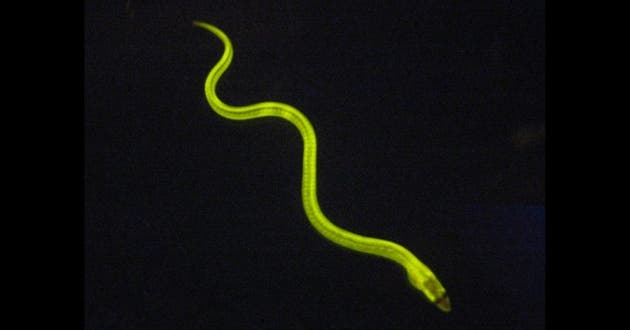
When shone in blue, the freshwater Japanese eel glows in a beautiful green light. (c) AKIKO KUMAGAI & ATSUSHI MIYAWAK
The Japanese freshwater eel (Anguilla japonica) is a popular choice on any sushi menu, but recent findings reveal that there’s more to it than just a simple snack. Biologists have identified a special fluorescent protein – the very first case found in a vertebrate – that makes the eel naturally glow in a bright green when shone with blue light. The protein could help researchers develop better bioimaging.
In just a few years, use of florescent proteins in biology has not only become a standard, but an indispensable tool. These molecules are developed in labs and are used to tag proteins or track how gene are expressed. In 2008, the Nobel Prize in Chemistry was awarded for work pertaining to the development of such molecules, and since then research has expanded their use even further as florescent proteins with varying hues and brightness have been introduced.
In nature, the only animals capable of expressing florescent proteins that we know of are invertebrates like microbes, jellyfish, and corals -until recently. This is why Japanese scientists were simply taken by surprise by the find, especially since the first identified florescent vertebrate is such a popular animal. Some of you reading this article might have even eaten it on more than one occasion.
The discovery wasn’t made in an eccentric sushi restaurant fitted with blue lights, but in a lab, after food chemists Seiichi Hayashi and Yoshifumi Toda found that eel muscle fluoresced naturally glowing green when a blue light is shone on it , while studing nutrients in eel at Kagoshima University in Japan. The find was quickly reported and molecular biologists quickly jumped on a the wagon.
Atsushi Miyawaki, a molecular biologist at the RIKEN Brain Science Institute in Wako, Japan, has worked extensively with florescent proteins in the past, specializing in those collected from jellyfish and corals. Him and colleagues seized the opportunity to study these novel molecules in the Japanese eel. Eventually, they isolated the gene that codes for the molecule, and have named the new protein UnaG, after the Japanese unagi, the Japanese word for freshwater eel.
“I don’t think anyone would have thought that eels would have such a bright fluorescent protein,” says Robert Campbell, a protein engineer at the University of Alberta in Edmonton, Canada. And UnaG is in a class of its own, he says. “It’s totally different” from other fluorescent proteins. “There’s not anything you can point to that’s the same.”
Most bio-imaging today is done with the now classic Green Fluorescent Protein (GFP), which shines in a green light thanks to a ‘chromophore’ that is part of the protein sequence. UnaG, however, fluoresces when it binds a naturally occurring small molecule called bilirubin, a breakdown product of haemoglobin. As such, UnaG could be used to measure bilirubin in human serum using an approach that could lead to simpler, more sensitive tests requiring smaller blood samples, says Miyawaki.
Next, scientists plan on insert the gene in mice and see how they develop onward. The findings were reported in a paper published in the journal Cell.









